MACHAME ROUTE
MACHAME ROUTE
To climb Mount Kilimanjaro on the Machame route means to share the mountain with many other trekkers.
Ever since the budget operators discovered Machame the traffic on the route has been growing. It soon overtook the Marangu route as the most heavily trafficked climb route on Mount Kilimanjaro.
The reason is not only that prices have been dropping. The Machame route is considered the most scenic route up Kilimanjaro.
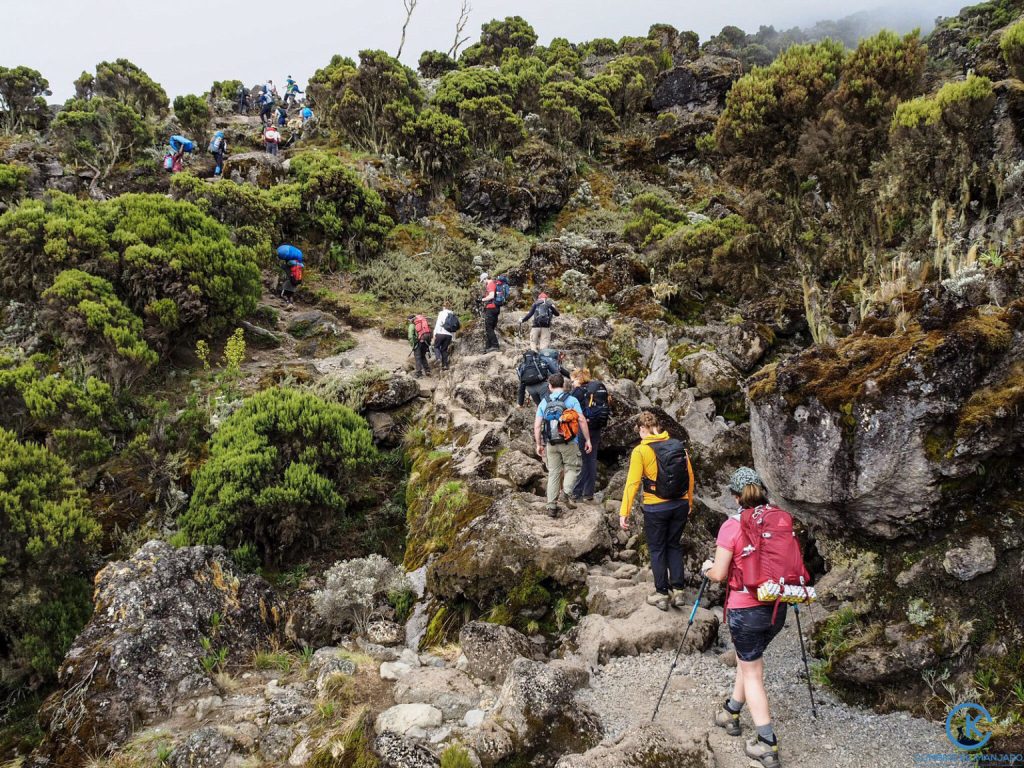
However, that’s not really true. The Machame route is a very scenic route, but not the only one. Both the Shira route and the Lemosho route share the same path as the Machame route after the first day or two. But they are less trafficked and ideally longer, so they are more expensive.
It would be more correct to say Machame is the most scenic Kilimanjaro route that you can climb with a budget operator.
(If it’s a good idea to climb Mt. Kilimanjaro with a budget operator, that’s of course a different question.)
Climbing Kilimanjaro on the Machame is considered to be more difficult than on the Marangu route or Rongai route.
Hence it’s jokingly called the “Whiskey Route”, a tougher climb than the “Coca Cola route” (Marangu). Now before you hit the back button to check out Marangu, consider that although the Machame route is supposed to be more difficult, the succes rates are higher on Machame than on Marangu!
Climbing the Machame route is more difficult, but not technically difficult.
Mostly it is simply a longer and often times steeper trek. It covers more ground and involves more ups and downs. It wears you out more, takes more energy, not more skill. But it offers much better acclimatisation!
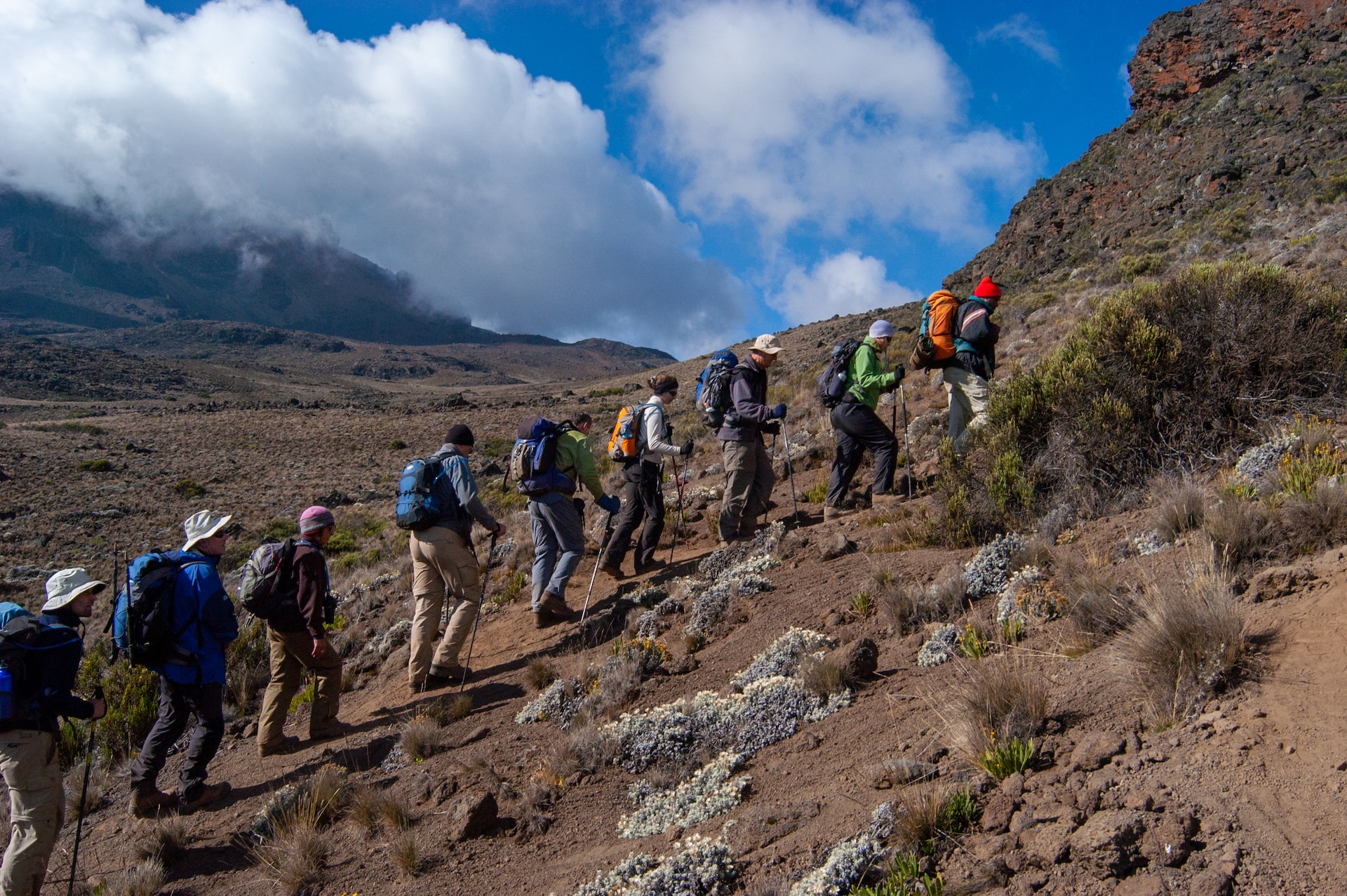
Some people are terribly worried about climbing the Barranco Wall. Don’t worry. It’s not a cliff face and it’s not a climb. It’s mostly a very steep path that requires you to use your hands every now and then and to scramble a bit in a couple of places.
If you are concerned, either about the scrambling or about the demands on your fitness, then you should consider the Rongai route. For a detailed discussion on which route might be the best for you see this page about all climb routes.
As for the Kilimanjaro climb on the Machame route, read the detailed description below.
Machame Route Itinerary
The itinerary below (and the detailed description below the itinerary) describes the six night/seven day Kilimanjaro climb on the Machame route. This is one possible variation of this route.
To shorten the below itinerary to six days you skip the night in the Karanga Valley and instead walk straight from the Barranco Huts to the Barafu Huts in one day.
Theoretically you could also extend the trek to increase your summit chances, but if you can afford a longer trek then the Shira or Lemosho route are better options. They share the same scenic path for the last four days to the summit but offer real wilderness and solitude on the first couple of days.
For experienced mountaineers there is also a challenging and dangerous specialist version via the Western Breach.
(Note: altitudes and distances are approximations. Different sources will give you different numbers.)
Starting Point: Machame Gate (1830 m/6000 ft)
Duration: 6-7 days
Day 1 – Machame Gate (1830 m/6000 ft) – Machame Huts (3030 m/9940 ft)
Walking distance: 5.5 km/3.5 miles
Walking time: 5-7 hours
Altitude gain: 1200 m/3940 ft
Day 2 – Machame Huts – New Shira Camp (3850 m/12630 ft)
Walking distance: 5.5 km/3.5 miles
Walking time: 4-6 hours
Altitude gain: 820 m/2690 ft
Day 3 – New Shira Camp – via Lava Tower (4640 m/15220 ft) – Barranco Huts (3985 m/13070 ft)
Walking distance: 10 km/6.2 miles
Walking time: 5-7 hours
Altitude gain: 135 m/440 ft (790 m/2590 ft to Lava Tower)
Day 4 – Barranco Huts – Karanga Camp (4040 m/13255 ft)
Walking distance: 5.5 km/3.5 miles
Walking time: 4-5 hours
Altitude gain: 55 m/185 ft
Day 5 – Karanga Camp – Barafu Huts (4680 m/15360 ft)
Walking distance: 3.5 km/ 2.2 miles
Walking time: 4-5 hours
Altitude gain: 640 m/2105 ft
Day 6 – Summit attempt via Stella Point (5752 m/18871 ft) to Uhuru Peak (5895 m/19340 ft) and descent via Mweka Route to Millenium Camp (3820 m/12530 ft) (or to Mweka Hut)
Walking distance: 5 km/3 miles ascent + 10 km/6.2 miles descent
Walking time: 5-6 hrs + 1-2 hours up, 5-6 hours down (the overall walking time may vary from 10 – 16 hours)
Altitude gain: 1072 m/ 3511 ft (Stella Point) or 1215 m/3980 ft (Uhuru Peak)
Descent: 2075 m/6810 ft
Day 7 – Millenium Camp – Machame Gate
Walking distance: 20 km/12.5 miles
Walking time: 5 hours
Descent: 1990 m/6530 ft
Climbing Mt. Kilimanjaro – Machame Route – Day 1
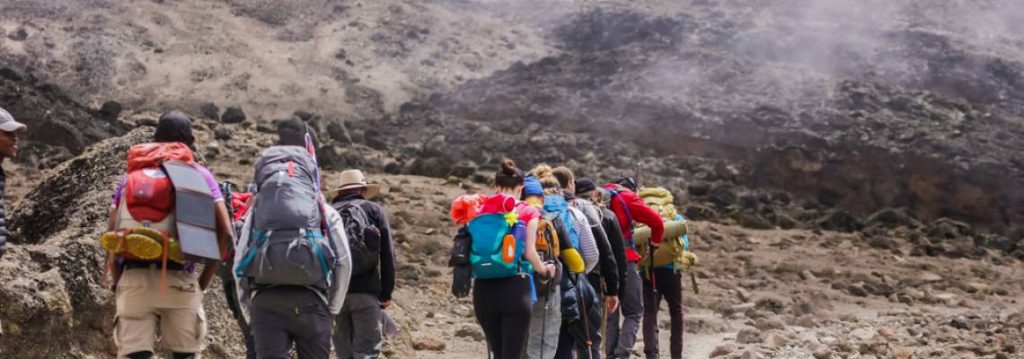
Your first day on Kilimanjaro starts with the transfer from your hotel to the village of Machame and the Machame gate. The drive from Moshi takes about 50 minutes.
Hopefully you will be able to drive to the gate, because heavy rain can make the last few kilometres impassable for vehicles. And then you’d have to walk.
Whichever way you get to the gate, once you arrive you will meet your guides and porters, you need to complete the registration formalities, and then you are off…
Your equipment has been distributed amongst the porters and they are already ahead of you. (If not, they’ll overtake you soon.)
The rainforest isn’t called rainforest for nothing. This side of the mountain sees a lot of rain, and this climate zone gets 96% of all rain on Kilimanjaro!
Even if it’s dry in the morning, chances are you will get a shower in the afternoon. You absolutely need excellent boots and rain gear from day one, as well as good protection for the stuff in your packs. And if you are unlucky you will be slogging through slippery mud to start with. (While the western routes see as much rain, the Machame route is the worst of all for mud underfoot.)
The first few kilometres you are following a four wheel drive track, but that soon becomes a neat, wide footpath.
The forest is beautiful, a real fairytale forest, lush and deep and green, albeit misty. (That’s why it’s also called “cloud forest”. It’s always in the clouds.)
Moss and lichen are dangling from the tall branches, tree ferns shelter underneath and impatiens and violas are flowering on the ground.
It’s about two and a half hours to a lunch stop in a clearing near a stream. And after lunch the same again, much through the same terrain, until you get to the Machame Huts Camp, your stop for the night.
The forest has gradually opened up. If you are lucky you have clear weather and you get your first peek at the Kibo peak.
Climbing Mt. Kilimanjaro – Machame Route – Day 2
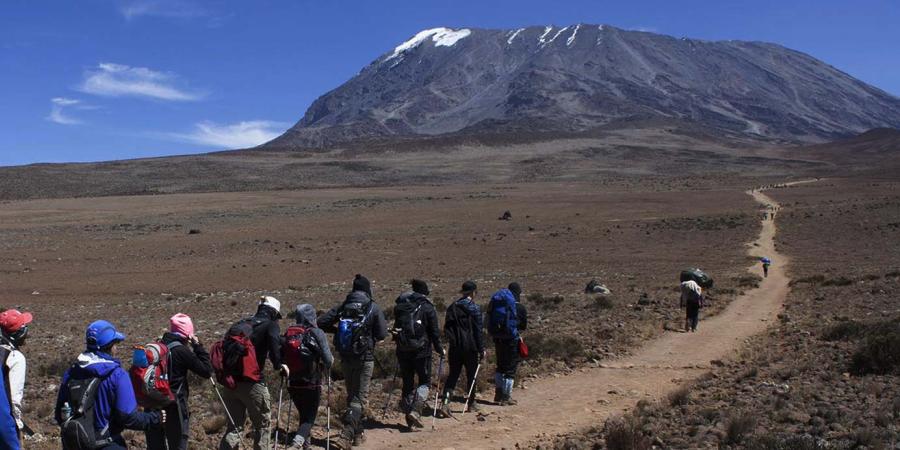
The Machame Huts marked the altitude where the montane forest gives way to the giant heathers of the moorland zone. The vegetation has opened up and, weather permitting, you will have great views. You can see Kibo, Mt. Meru in the distance and also Machame way down below as you make your way up towards the Shira Plateau.
(By the way, the Shira Plateau is what’s left of Kilimanjaro’s third peak, the other two being Kibo and Mawenzi.)
This is also the first day that you will find the giant senecios and lobelias growing along the path.
The trail is much steeper today, especially until you reach your lunch stop.
Luckily it’s a short day. After lunch it should take only an hour or so to reach the edge of the Shira Plateau, and from there your camp is not far.
You covered little distance but a fair bit of height today. Some people may start to feel the latter.
The taller vegetation has all but disappeared and the scenery is starting to look barren, more like a real mountain.
Your tent tonight will definitely be “a room with a view”: Kibo, the Western Breach, the Shira Cathedral, the Needle… And whether it’s coincidence or not, many of the best sunset shots from Kilimanjaro seem to have been taken from here.
Climbing Mt. Kilimanjaro – Machame Route – Day 3

Today is a long day. The first part of the day is spent climbing up towards the Lava Tower, a 100 m/300 ft volcanic plug, left over from times when Kilimanjaro was volcanic. It’s a gentle slope and as you climb towards it the landscape becomes sparser still. Even the short heather disappears altogether to reveal the rocky ground of the lava ridges.
Though not as steep as yesterday’s, the climb is often experienced as more strenuous. After all, you’ll be climbing up to over 4500 m and your body will sure notice the the lack of oxygen!
After a much deserved lunch break near the Lava Tower you descend into the beautiful Barranco Valley, the result of a massive landslide some 100,000 years ago. The valley is sheltered by towering cliffs and is much greener. The senecios and lobelias are back. You have great views across the plains way below and you also get your first glimpse of the Barranco Wall. You will climb it tomorrow.
The Barranco Camp is without a doubt the most spectacular campsite of this route, with fantastic views of Kibo, the Western Breach and the first of the southern glaciers, a fitting reward after a strenuous day.
Don’t be surprised if you have slight symptoms of altitude sickness. You have been quite high today, but by climbing high and sleeping low you are giving your body the best chances to adapt. Don’t be disheartened about the loss of hard earned altitude. This was an important day for acclimatisation.
Whether climbers reached the Barranco Camp via Machame, Shira, Lemosho, or even on a special route around the northern circuit, from this point onwards all climbers follow the same trail.
Kilimanjaro Climb on the Machame Route – Day 4
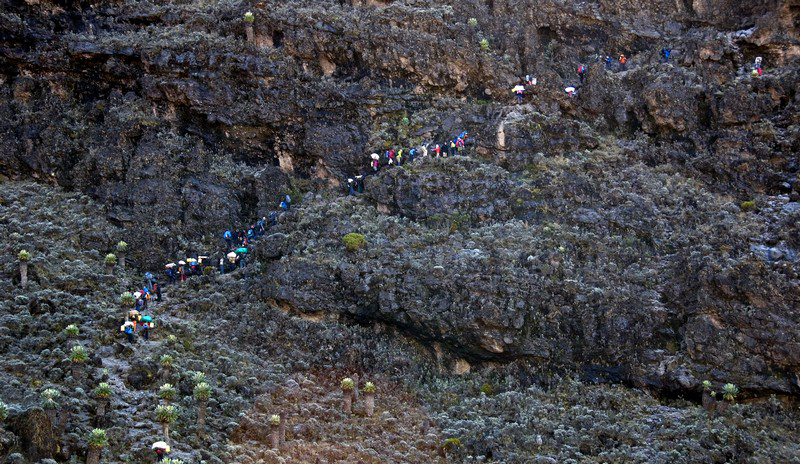
Today, first thing in the morning, you will tackle the Barranco Wall.
There are stories about the Barranco Wall “requiring significant climbing experience”, being “almost impossible” or “perilously dangerous”. That’s not true I find.
It is strenuous to climb because the air is already so thin and it is very steep. And if you never set foot on any mountain in your life it may in places appear a little precarious. But in no way does it require climbing experience!
The wall is exposed and you will use your hands to steady yourself, but you can pretty much walk all the way to the top. Only at a few points do you need to scramble. (And you don’t need experience to scramble.)
Don’t forget to turn around every now and then and admire the views, including the line of climbers/ants behind you.
The wall takes about an hour and a half to scale, and as you come over the final ridge you are met with a breathtaking view of Kibo, which all of a sudden looks a lot closer!
You’ll have a short break to enjoy the stunning views, and then it’s down again on a much gentler slope. From here it’s another couple of hours over volcanic scree and through several small, sheltered valleys until you reach the Karanga Valley Camp.
The narrow and steep Karanga Valley is a green oasis, albeit a cold, windy one. The camp is on the other side of the valley (another climb…) and you can spend the afternoon resting, exploring, or chasing that perfect picture of one of the iridescent, malachite sunbirds that live here.
Kilimanjaro Climb on the Machame Route – Day 5
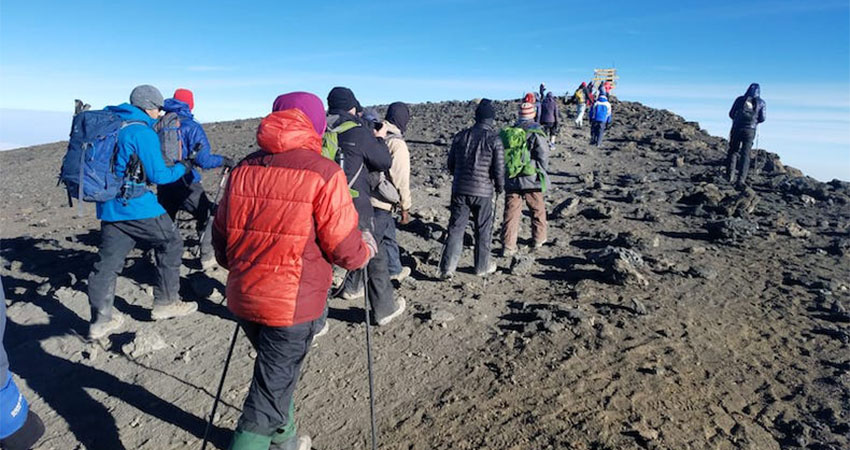
The walk today is short. You leave the Karanga Valley on an easy but steep path, through an increasinlgy inhospitable landscape, with the Southern Glaciers looming to your left. The path keeps getting steeper until you reach the Barafu Camp for lunch.
This is the benefit of having the extra night at Karanga in your schedule. You have plenty of time to eat, rest and recover, prepare everything for the summit attempt, maybe even go on a short acclimatisation walk, eat some more, and then have an early night. Tonight is the night.
Barafu Camp has an otherworldy feel to it, perched on an exposed ridge in a bleak and barren landscape. Do familiarise yourself with the area before the sun goes down! It is quite possible to simply step of the edge if you have to stumble around in the dark to find the toilet…
Kilimanjaro Climb on the Machame Route – Day 6
I hope you arrived at Barafu Camp early enough to get plenty of rest. (Climbers on shorter treks skipped the Karanga Camp and may not have.).
Your day pack should be ready with everything you will need tonight: rain gear if you aren’t wearing it anyway, enough water, hand warmers, balaclava… You should have fresh batteries in your head torch and camera and you should already be wearing the right clothes. Make sure everything you are wearing is bone dry!
This day will likely go down in your memory as the most physically challenging day in your whole life. Likely it will also be one of the earliest starts you ever made…
Your guides will wake you up some time between 11 pm and 1 pm. There will be some hot drinks and maybe some food, but mostly it’s a matter of crawling out of your sleeping bag, putting on a few more layers of clothes, your boots and your head torch. Grab your day pack and off you go…

After an initial little scramble over some small cliffs to get out of the Barafu Camp, the path becomes easier to follow. But it doesn’t take long and you reach a sharp turn to the left. And then it starts, the endless succession of switchbacks, snaking back and forth, back and forth, up the steep slope of loose, volcanic scree that is the side of Kibo Peak.
As steep as the slope is, due to the many switchbacks the path itself isn’t all that bad. However, the scree is lose and you keep sliding down, and nothing’s easy without oxygen. The air is incredibly thin, getting thinner all the time.
You may feel horrible. Don’t push yourself too hard. Take all the time you need and for goodness sake don’t let anyone pressure you into moving faster than you feel comfortable to. Steady, steady, one tiny little step after the other.
Other groups overtaking you? Let them go!
It doesn’t matter if you reach Uhuru Peak or even the rim in time for sunrise. It only matters that you reach it and that you will be able to get back down safely! You can not move too slowly on Kilimanjaro.
The people who do not feel the effects of the altitude are few and far between. Hopefully the worst you have to deal with is a headache and the occasional wave of nausea. Throwing up is not as uncommon as you might hope and is no reason for concern. It’s only awful.
It’s impossible to have long breaks in these temperatures. The cold starts creeping into your hands and feet first, then into your whole body.
When you cross a frozen stream and notice some boulders you are very close! It’s about 30 minutes to the rim from here, but that last bit of slope is cruel, the steepest and hardest part of the whole night… But you won’t be giving up now, right?
It takes most people five to six hours to reach Stella Point. If you are among the slower climbers, don’t worry. The break of dawn invariably provides a much needed boost of energy for those last metres, and before you know you will be up there, admiring the rising sun from 5752 m/18871 ft.

Congratulations to you, for you have done well!!
The park authorities will reward you with a certificate, even if you decide not to continue along the crater rim past the glaciers to Uhuru Peak.
The good thing about reaching the crater rim at Stella Point rather than Gilman’s (like the Rongai and Marangu route would): it may be harder to reach the rim, but from here to Uhuru peak it’s only 45 minutes. A piece of cake… (Not!)
Even though most consider the climb up to Stella Point the hardest part, the walk around the rim can prove challenging, too.
The more time you spend at this extreme altitude, the more you will feel it. The path rises steadily. It may not look steep, but by now every step uphill can be a battle.
(Mind you, for other people it’s a breeze, but it’s certainly better to be prepared for the worst and find it easier than expected, than the other way around.)

Congratulations again. What you just accomplished is truly impressive and no matter what you expected, the reality of it will be totally different. Some people get very emotional, some are on a big high, some are so dazed, they barely take any notice at all. There is no way to describe or imagine the experience of climbing to nearly 6000 m altitude.
It’s time for hugs and photos. There won’t be time for much else, because it will be too cold and also too dangerous to remain at this altitude for more than a few minutes.
You probably don’t have the tiniest little bit of energy left now. Well, guess what? The day has only begun and it’s another long day…
You now have to drag yourself back to Stella Point. From there it’s nearly 1100 m down, down, down… Until you get back to Barafu. The descent is cruel on the knees and you will appreciate the walking poles!
If you scree run then this isn’t too bad. It’s actually quite fun. And fast! But pity those who have to stagger back down the same way they came up, switchback for painful switchback.
Lunch should be waiting for you at Barafu. You just want to collapse and sleep; you can not imagine getting up from that chair again. But after what you have done to your body today it is not safe to remain at this altitude. You have no choice but to pack up your gear and keep going, the sooner the better. Down and down you go, for several more hours, to Millenium Camp or Mweka Huts, whichever your tour company chose.
What will happen now is something of a miracle. Because as you descend further there will be air again. Oxygen! Lots of it!
Oxygen is life and that is exactly what will be injected back into you. You may not believe this now, but there is a good chance that after this additional descent you may feel better and have more energy than you did at lunch time.
Dinner is often a much livelier affair, with everybody’s eyes shining as they recount the experiences of the day. And I have no doubt that you will sleep well tonight!
Kilimanjaro Climb on the Machame Route – Day 7
After beakfast you set off, down, down, down again. It’s your last day on the mountain and you may have trouble getting enthusiastic about your surrounds.
What you will probably notice more is the fact that the path is rather steep, and that the steps on the steepest sections are hell for your abused knees.
The day takes you through some really pretty forest with lots of birdlife. Try to muster some interest. It may distract from the pain.
Once you get to the gate you’ll have to endure some more formalities, but eventually you will say good bye to your guides (a sad and emotional moment), climb into the vehicle waiting for you and be whisked away to your hotel for hot showers and cold beers.
